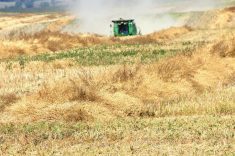Chickpea producers may be focusing on strong kabuli prices, but they should also keep an eye on what is happening in their bins.
Saskatchewan farmers harvested a decent quality chickpea crop, but there is some risk it could deteriorate while in storage.
“It’s a very high-value crop and so it truly does pay to make sure you don’t get any spoilage or stuff like that in the bin,” said Ray McVicar, special crops specialist with Saskatchewan Agriculture.
Two years ago processors complained about the deterioration of the chickpea crop due to heat and moisture problems in storage bins.
Read Also

Alberta researcher helps unlock the economics of farming
Lethbridge Polytechnic researcher helping agriculture producers with decision-making tools in economic feasibility
McVicar doesn’t think that will be a significant dilemma this year, but he said chickpeas are tricky to store. The moisture level for safe storage is 14 percent.
The seed is so big that the moisture reading on the coating can be different than moisture levels inside the seed. It’s not like a cereal crop where one moisture test might suffice. Chickpeas require multiple tests.
“The seed actually sweats in the bin. That moisture will congregate in one area and then that’s when you get spoilage in that area,” McVicar said.
“Because there could be considerable change in the results of a moisture test over time, the stored grain should be tested several times during the first few weeks. Producers should break open some seeds. If the seed is dry, the interior should sna-10-P. A soft and chewy seed interior may lead to spoilage.”
Saskatchewan producers seeded about 700,000 acres of chickpeas in the spring, but fewer acres were harvested because of disease.
It will still be a record crop and top quality kabulis are fetching about $22 a bushel this fall, McVicar said.
“It’s worth it to go and look and make sure you maintain the quality. It would be just a shame to have something like that spoil.”
Producers should use aerators to cool the seed if there are moisture or temperature problems. If their bins are not equipped with a fan, farmers will have to move the grain manually.
However, chickpeas are delicate and extra handling will increase the risk of chipping, peeling and cracking.
McVicar advises producers against handling chickpeas once the temperature dips below -15 C. The seed coat becomes brittle and that can lead to more damage.
But he doesn’t anticipate producers holding onto the crop too long.
“With kabuli chickpeas being at a high price right now, it doesn’t really make much sense to store them. You could store them for a month or two trying to get a higher price I suppose, but I sure wouldn’t wait until next year because (the price) could be down a long ways.”















